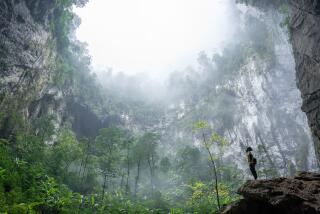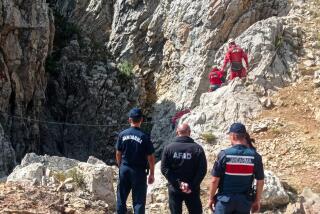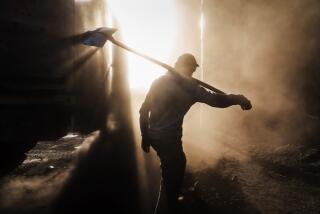Search for Bin Laden Will Use U.S. Gadgetry, Afghan Hunters
- Share via
WASHINGTON — Pentagon strategists are mapping out a plan to hunt down Osama bin Laden and Taliban leaders in a manner that spares U.S. soldiers the perils of a cave-by-cave search, relying instead on American air power, opposition fighters and bounty hunters.
Military planners said Monday that there is virtually no chance that they will risk exposing U.S. special operations forces to underground confrontations that could prove deadly, when new technologies and willing allies can do the job. Instead, military strategists plan to use thermal and gas imaging to find gatherings of cave-dwellers.
If all else fails, the anti-Taliban coalition will simply wait until Taliban forces run out of food and emerge from their hide-outs.
“You can rush and take heavy casualties, or you can be patient,” a Pentagon official said, on condition of anonymity. “Why would I do that when we’ve got 50,000 opposition fighters on the ground who are willing to do it?”
Defense Secretary Donald H. Rumsfeld said he had no doubt that some of the natural caves and man-made bunkers capable of concealing Bin Laden and senior Al Qaeda and Taliban leaders have already been searched. But he made it clear that Americans were not involved.
“If we were to do that, I would not be discussing it,” Rumsfeld said. “And we have large rewards out, and our hope is that the dual incentive of helping to free that country from a very repressive regime . . . coupled with substantial monetary rewards will incentivize . . . a large number of people to begin crawling through those tunnels and caves, looking for the bad folks.”
Asked if additional soldiers would be needed to search the caves, Rumsfeld said he had met his goal for the number of U.S. Special Forces in Afghanistan, which he said is several hundred. Other forces would conduct the search, he said. Pentagon officials said they would not be Americans.
At least some caves are being searched by anti-Taliban militants and by entrepreneurs willing to risk their lives for the $25-million rewards the United States has offered for Bin Laden and the Taliban leader, Mullah Mohammed Omar. Even as fighting continued in pockets of Taliban resistance, several bounty hunters have sent photographs of suspect caves to the foremost U.S. expert on the Afghan cave system.
“People looking for the reward over in Afghanistan started e-mailing me, sending me photos of bunkers where they knew Bin Laden had been,” said John F. Shroder Jr., a University of Nebraska geologist and geographer. His maps of Afghan caves were posted on a university Web site until the FBI asked him to take them down.
“I knew some of it was real because I had seen, from people we don’t talk about, similar pictures,” Shroder said, referring to U.S. intelligence officials.
Natural caves are carved into the rocks of Afghanistan, particularly near Kandahar in the south, Shroder said. Man-made canals from the era of Alexander the Great carry water through the mountains.
But Bin Laden and other members of the Al Qaeda network blamed for the Sept. 11 terrorist attacks on the Pentagon and World Trade Center are believed to be hiding in man-made bunkers that in some cases run several stories deep, with escape hatches.
The bunkers lie deep in the mountainside near Jalalabad in the northeast and near the Taliban’s onetime stronghold of Kandahar, now a battle zone between Taliban and ethnic Pushtun opposition fighters.
Bin Laden, son of a Yemeni construction magnate, has reinforced his bunkers with steel doors, Shroder said.
Shroder would not reveal how he learned this information, but he said, “The precise latitude and longitude coordinates are rather known in Washington now.”
The man-made tunnels are carved into granite and gneiss, extremely durable rocks, much like the NORAD air defense facility that is largely submerged beneath the Rocky Mountains near Colorado Springs.
Pentagon officials say Army Gen. Tommy Franks, the U.S. commander of the Afghan campaign, has learned key lessons from the Soviet Union, which lost many soldiers amid the knives and booby-traps of the moujahedeen cave complexes. One thing he learned was to use the latest gadgetry of warfare.
The density of the rock makes it difficult to attack. U.S. forces have used deep-penetrating “bunker buster” bombs, and they also could send cruise missiles into cave openings or use explosives designed to suck the oxygen out of bunkers, suffocating anyone inside. Laser-guided missiles on Talon gunships could be trained on the hide-outs. Activity in the caves could be tracked using reconnaissance planes equipped with thermal-guided cameras and devices that can pinpoint the carbon dioxide emissions of a Taliban fighter exhaling.
Using technology and local bounty hunters who search at their own risk is expected to spare special operations forces the kind of casualties Soviet fighters encountered. Instead, U.S. Army Rangers, Green Berets and other special operations troops can remain busy blocking roads in search of fleeing Taliban leaders, helping bomber pilots target suspected Taliban sites and gathering information on enemy troop movements.
“For the most part, the special ops have been . . . making assessments and interdicting roads and looking for supplies moving north or south or east or west, attempting to prevent people that ought not to be going places from going places,” Rumsfeld said.
Rumsfeld is scheduled Wednesday to be briefed on the Special Forces during a visit to Ft. Bragg, N.C., the army’s largest special operations training facility.
Those soldiers will not have to worry about being sent to Afghanistan to forage through booby-trapped caves, a senior Pentagon official said.
“If we go searching cave to cave . . . we’re going to get people killed in large numbers on a wild goose chase,” he said. “We don’t need to. We can sustain this. We can do this forever.”
More to Read
Sign up for Essential California
The most important California stories and recommendations in your inbox every morning.
You may occasionally receive promotional content from the Los Angeles Times.













